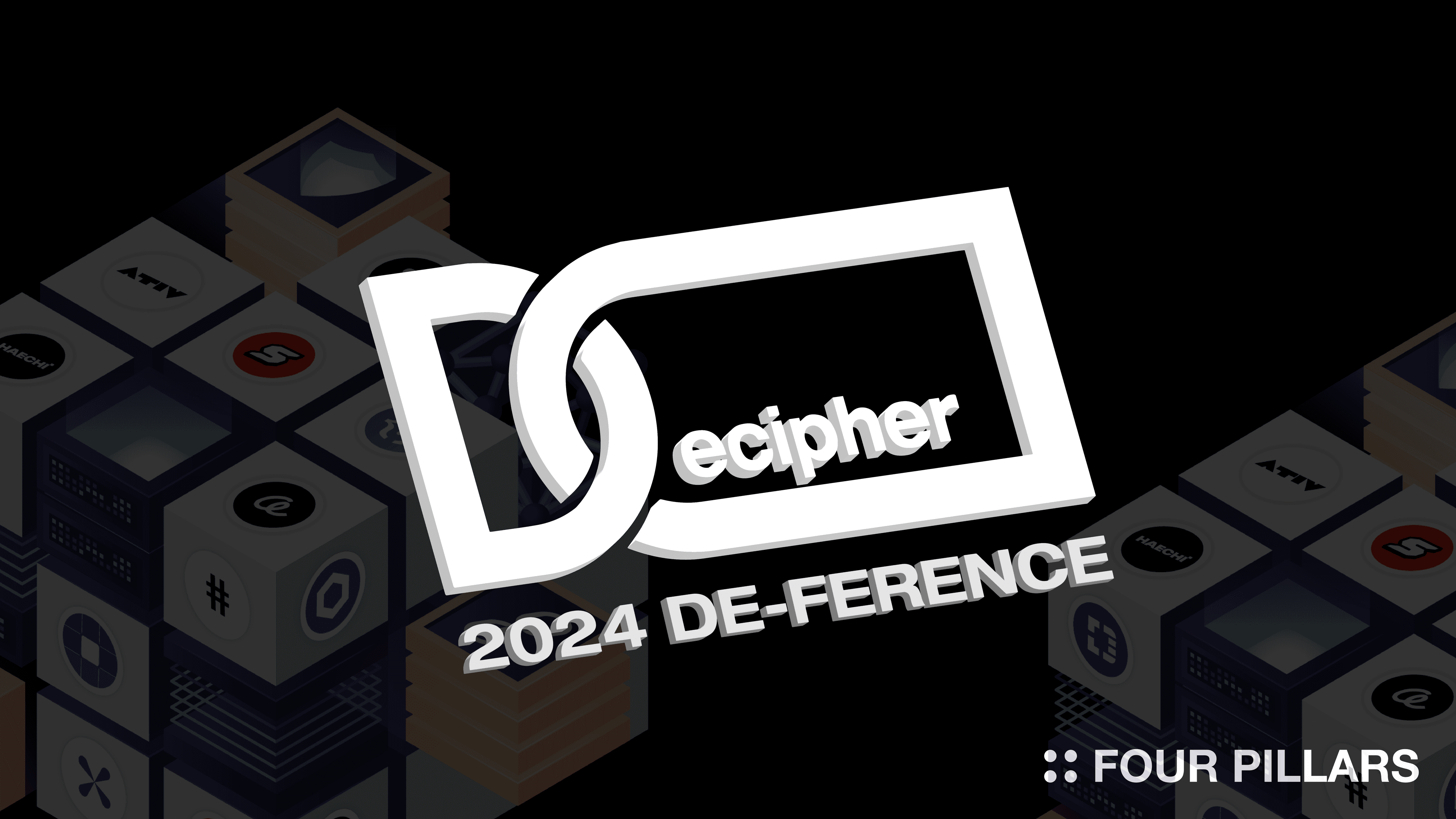
※ This article series covers the DeFerence 2024 event, sponsored by Four Pillars, and is published in three parts. This article is the third part of the series, and all attached presentation images were captured from the YouTube recording.
Part I - [Recap of Deference 2024] #1: Contribute to the Blockchain Ecosystem
Part II - [Recap of DeFerence 2024] #2: Blockchain, Reaching the Masses
Part III - This Article
In the previous articles, Part I - "Contribute to the Blockchain Ecosystem" and Part II - "Blockchain, Reaching the Masses," primarily focused on data and applications. In this Part III - "Discussing the Present and Future of Blockchain Infrastructure," the emphasis is on blockchain infrastructure. We cover the keynote speech on the value of blockchain by the A41 team, as well as various presentations and panel discussions on topics such as L3, ZK rollups, monolithic vs. modular blockchains.
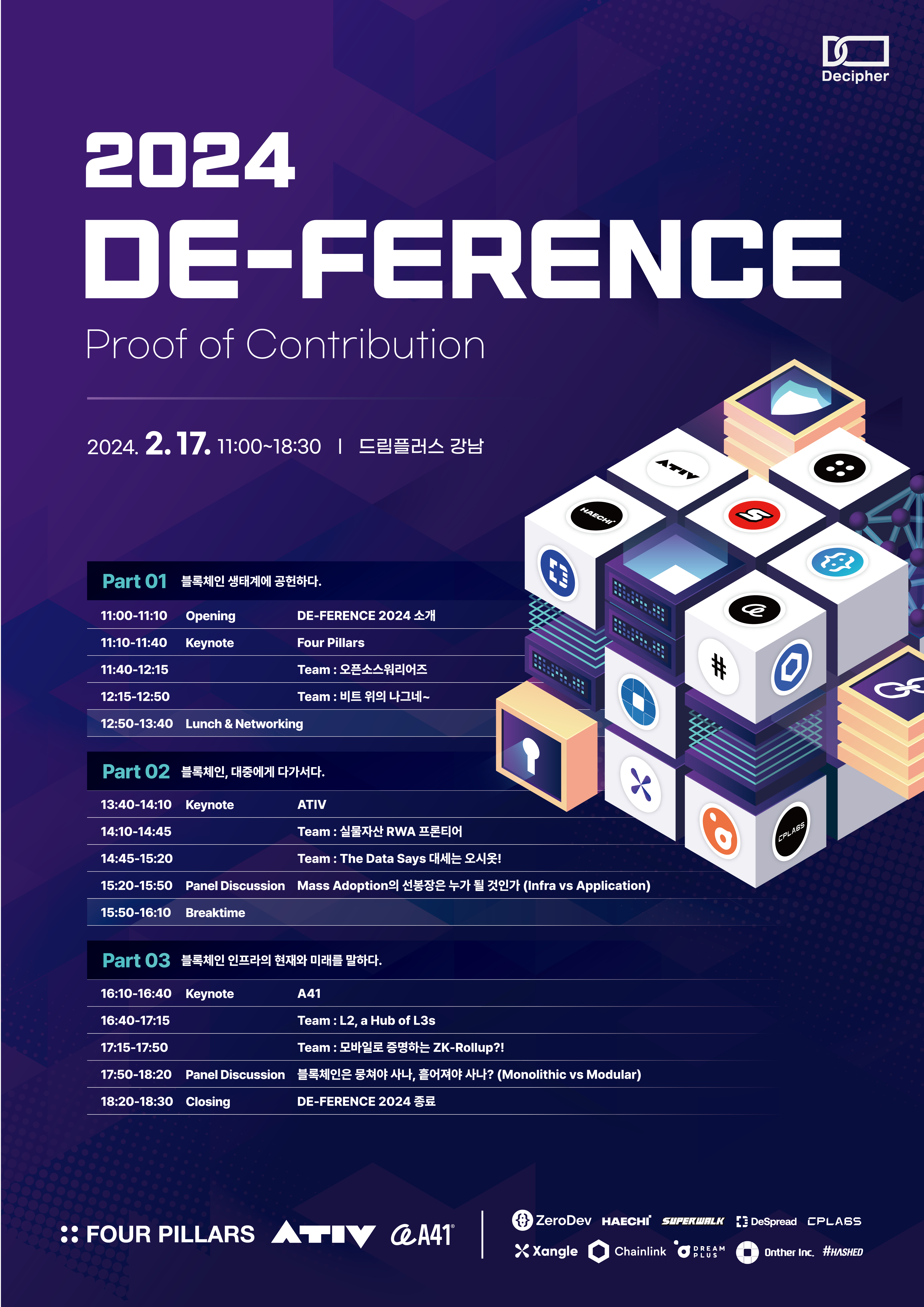
Overview
Jooman Han of the A41 team introduced the potential value that blockchain can offer and the inherent issues present within the blockchain industry. Despite the various challenges, he emphasized why we must continue to pursue the fundamental value of blockchain. To truly realize these values, Han stressed that Web3, like Web2, must focus on solving practical problems.
Comments
Although the blockchain industry has developed significantly over time, it still seems far from being perfectly applied in the real world. This is because the value blockchain can provide and the range of problems it can solve are vast. From this perspective, Jooman Han's explanation of one of blockchain's issues, the 'lack of a business model (BM),' was particularly interesting.
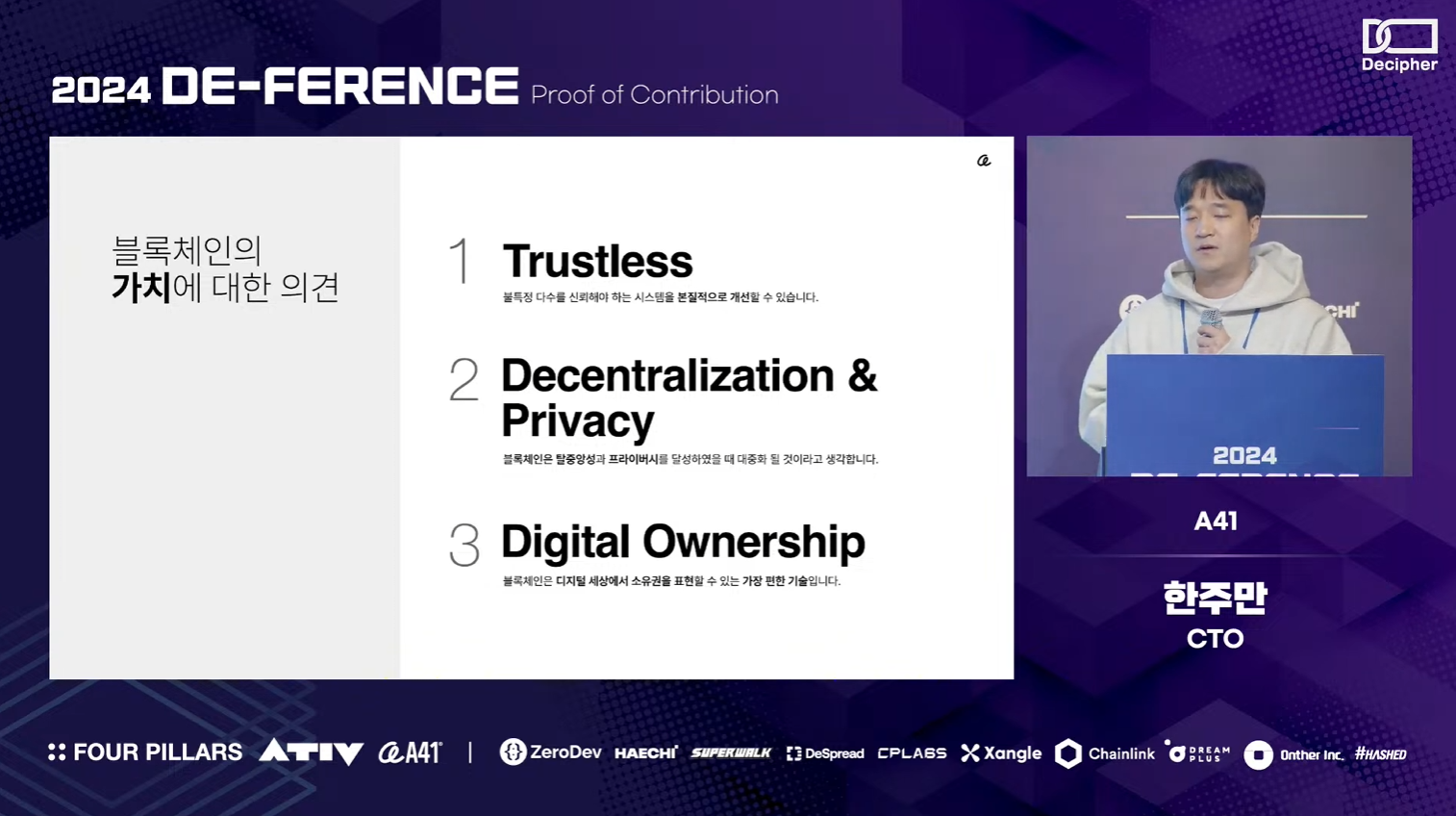
The A41 team identifies three main values that blockchain can offer: 1) Trustless, 2) Decentralization & Privacy, and 3) Digital Ownership.
First, Trustless: Blockchain provides a secure system where there is no need to trust unknown parties, thanks to consensus algorithms and the concept of a distributed ledger. This is the first time in human history that such a system has been possible.
Second, Decentralization & Privacy: The team believes that achieving decentralization and privacy is crucial for mainstream adoption. However, current hardware limitations make it difficult to achieve both decentralization and scalability simultaneously, and implementing privacy features often results in a trade-off with user experience.
Lastly, Digital Ownership: Blockchain is the most convenient technology for ensuring ownership in the digital world.
However, the value of blockchain is hindered by several issues, including 1) the lack of a BM, 2) easy copying, and 3) legal and compliance challenges.
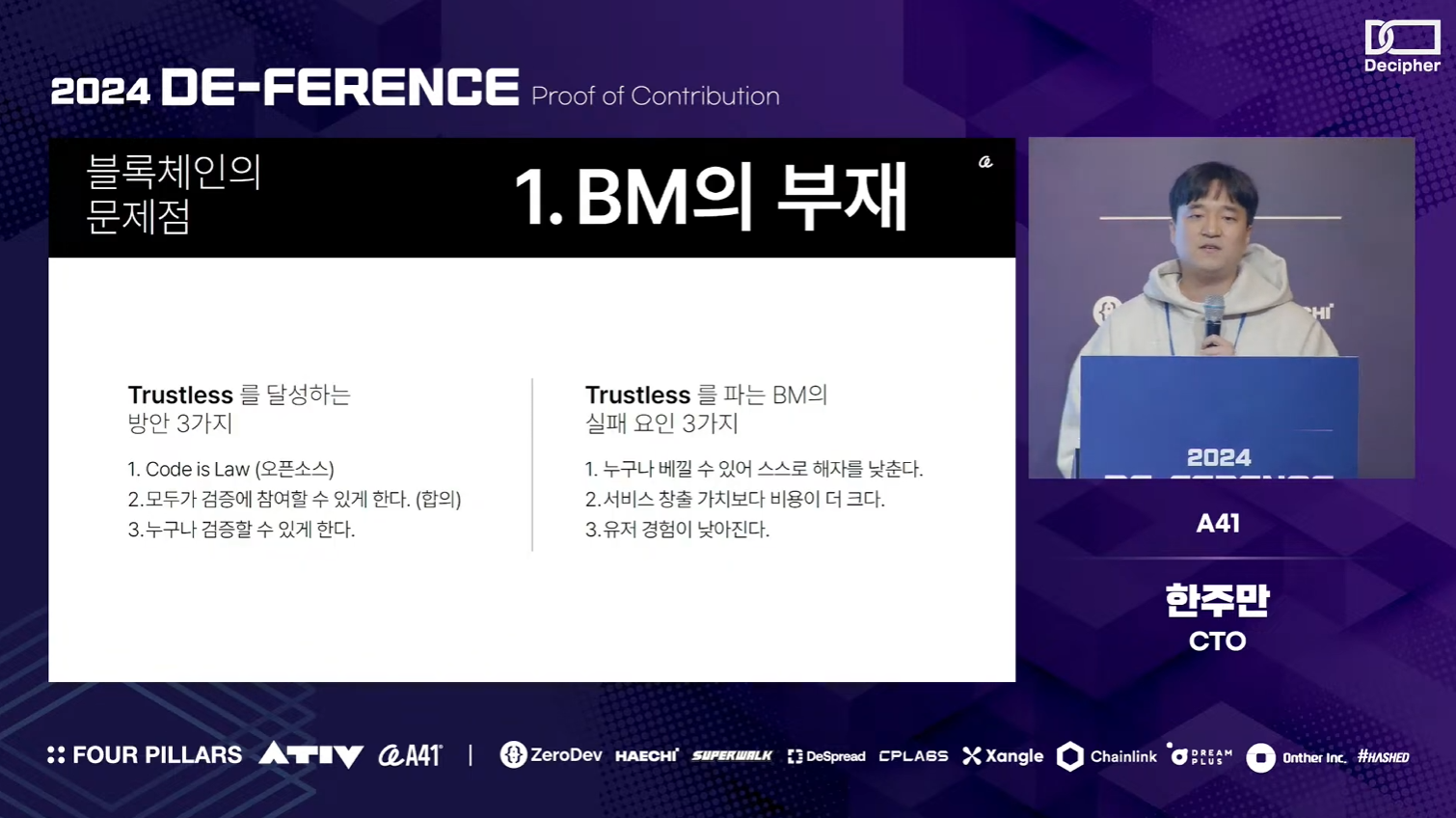
First, to achieve trustlessness in blockchain, the protocol must be open source, allowing anyone to verify the code. Additionally, to maintain a decentralized system, the consensus algorithm must be finely tuned, enabling anyone to participate in the transaction verification process. However, these conditions paradoxically hinder blockchain-based services from finding suitable business models - making the code open source lowers the technical moat, as anyone can copy it. The introduction of a consensus algorithm adds extra communication costs compared to traditional web2 services, potentially reducing profitability. Allowing anyone to verify transactions can significantly degrade the user experience, making it harder for the service to be widely adopted.

Another issue in the blockchain industry is the distorted incentive structure centered around protocol founders. While some develop products without issuing tokens, or issue tokens under a proper decentralization roadmap, many opt for indiscriminate token minting with an exit strategy in mind from the beginning. This approach undermines the sustainability of the product.
Lastly, the biggest challenge in the blockchain industry is related to law and compliance (particularly in the South Korean market). Despite the many areas where blockchain could provide solutions to existing industries, numerous businesses cannot even get started due to inadequate laws and regulations at the national level.
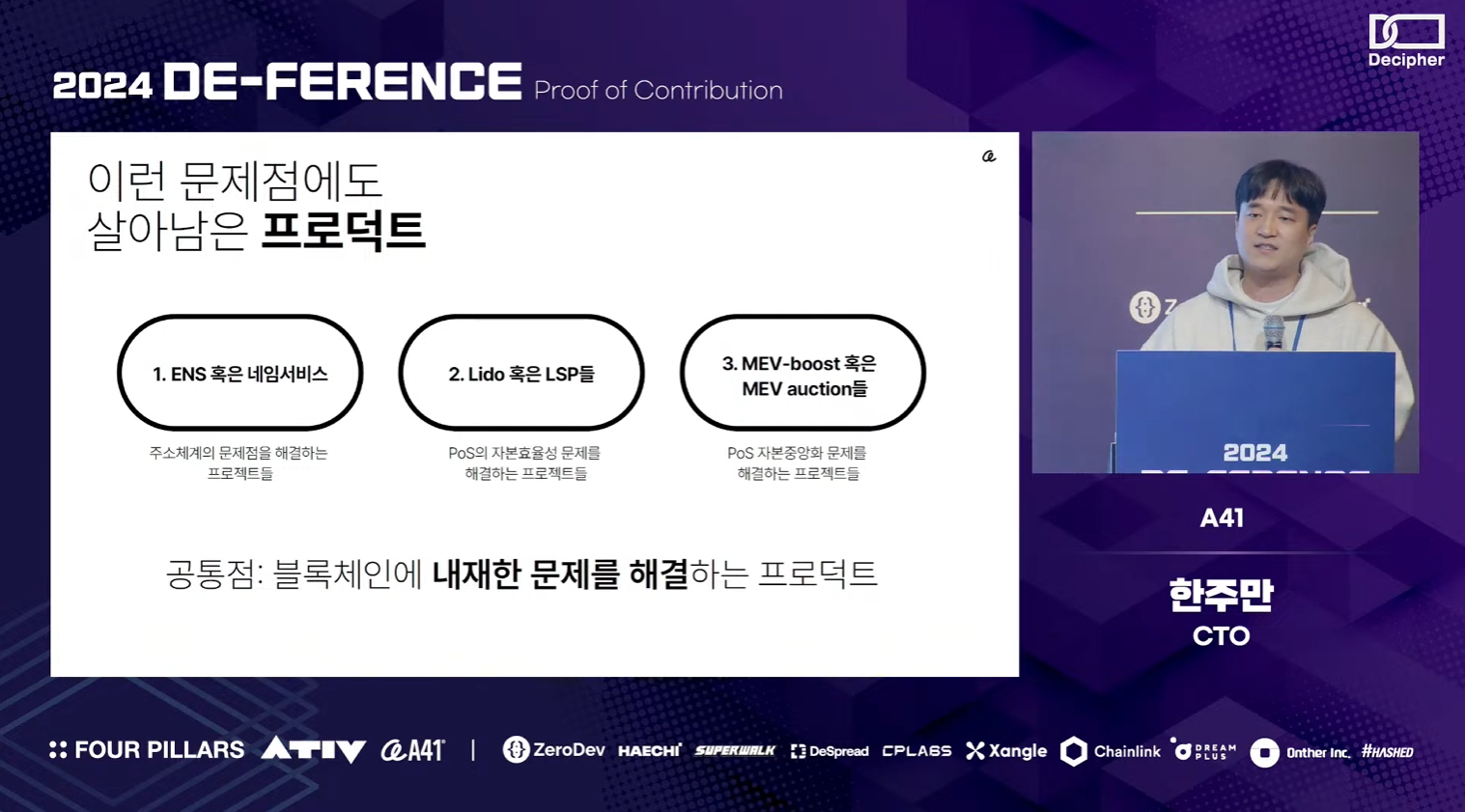
Nonetheless, services like ENS, Lido, and MEV-Boost have managed to create real value despite the bear market. Their commonality lies in addressing inherent issues within the blockchain ecosystem: ENS solves problems related to blockchain address systems, Lido addresses issues with Ethereum network's PoS, and MEV-Boost tackles centralization problems in PoS, thereby providing value to users.
Overview
The L3 team introduced the advantages of L3 over L2 and presented a new design for L2 to maximize these benefits. Firstly, they pointed out that contrary to popular belief, L3 does not significantly improve scalability but offers substantial advantages in interoperability. They also introduced a new system design that uses L2 as a shared sequencing layer to maximize interoperability between L3 networks, explaining this through 1) transaction flow and 2) the bridging process.
Comments
Recently, many L3 networks have been launched. However, most projects tend to simply ride the L3 narrative or rely on the marketing of the underlying L2, without deeply considering the actual advantages of L3. I found it particularly interesting that the L3 team identified this issue and proposed a new design that maximizes the benefits of the L3 system.
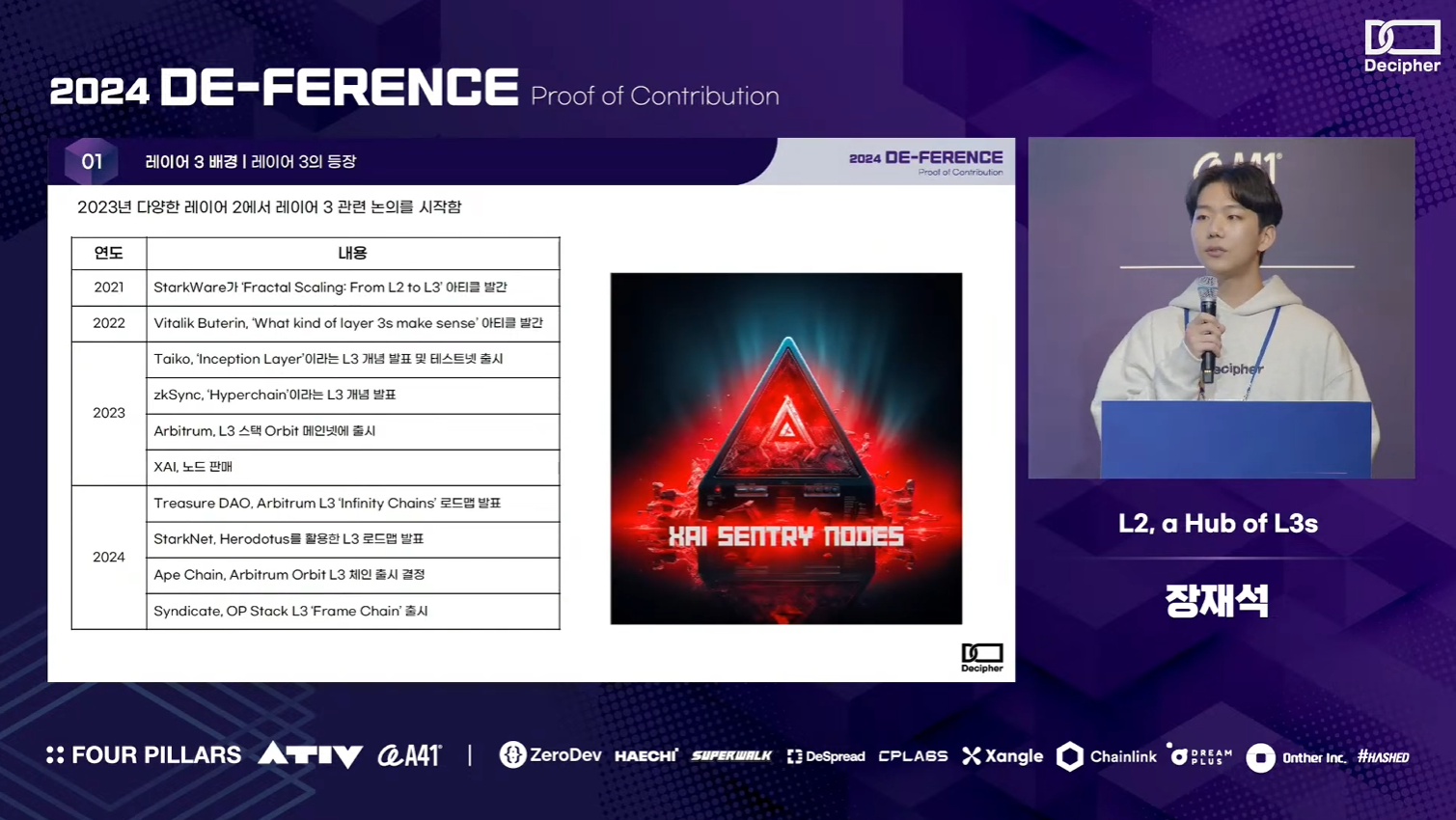
L3 was first discussed in StarkWare's Fractal Scaling initiative in 2021. In 2022, Vitalik Buterin began to seriously explore the potential of L3, and since then, numerous Ethereum scaling projects like Taiko, zkSync, and Arbitrum have started to implement L3 technology. Despite the increasing mentions and launches of L3 projects, detailed discussions within the Ethereum community about why L3 is necessary, what problems it can solve, and its actual architecture have been relatively lacking.
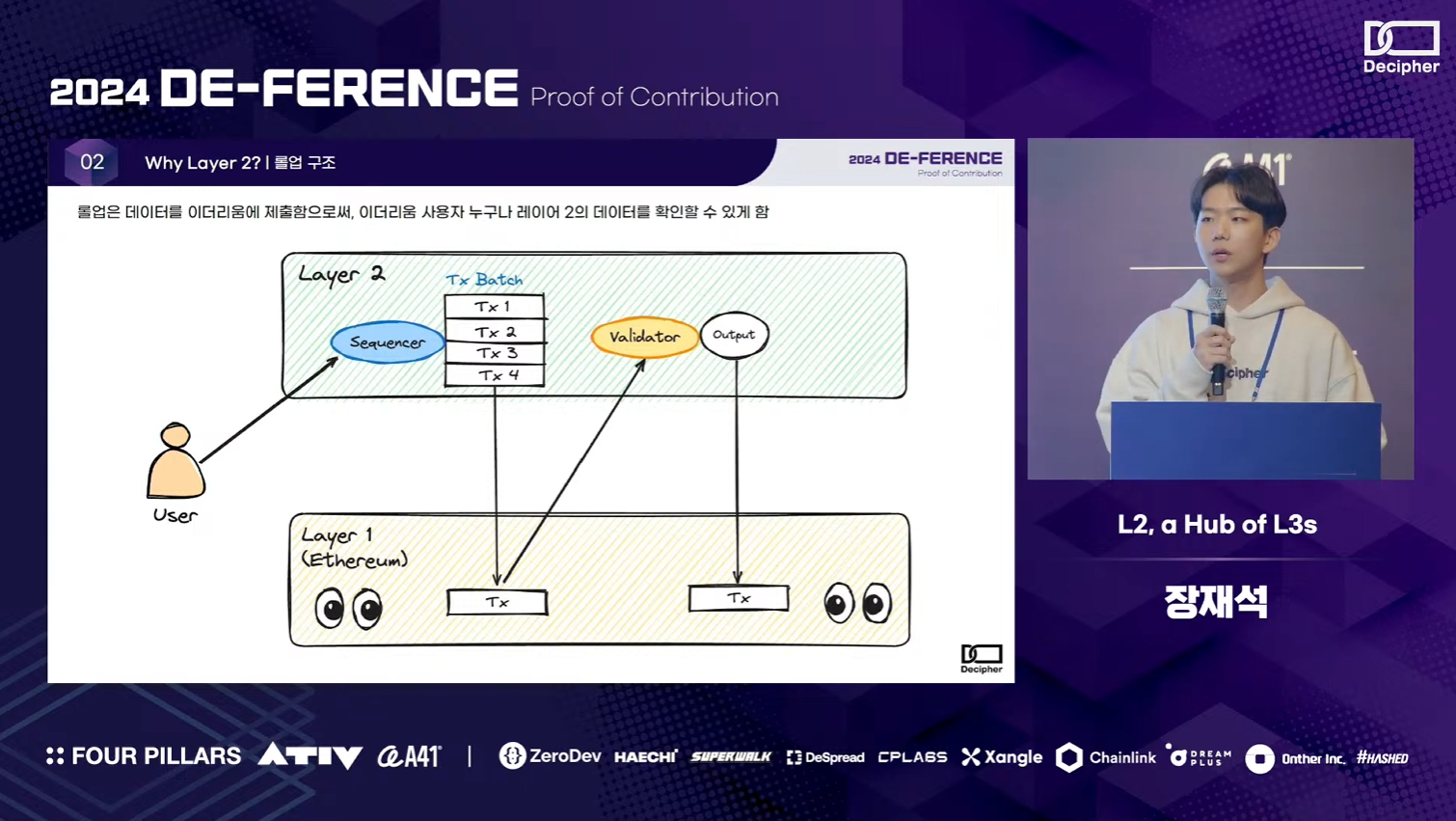
Why should we use L3 when we already have L2?
Before we think about the answer to this, let's take a look at L2. L2 refers to Ethereum scaling solutions and is a separate blockchain that inherits Ethereum's security. L2 can be divided into four types based on proof methods and data storage methods: Optimistic Rollups, ZK Rollups, Optimium, and Validium. The structure of L2 rollups is as follows: a sequencer collects user transactions, batches them, and submits them to Ethereum. Because Ethereum nodes can access these transactions, rollups can inherit Ethereum's security. Validators of the rollup calculate the results of the submitted transactions and resubmit them to Ethereum.
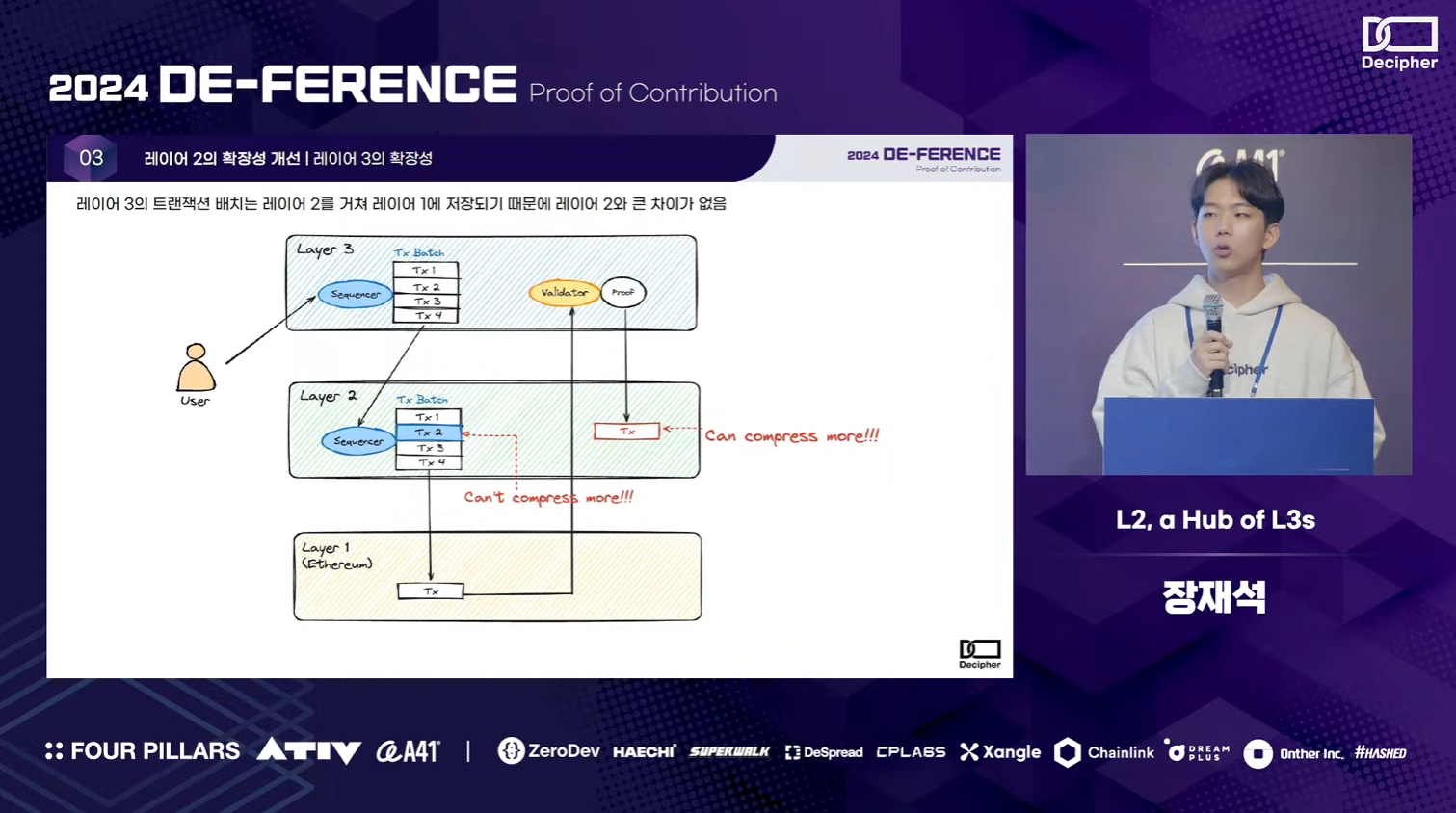
Now, let's revisit why L3 should be used. The first reason is the potential to improve L2 scalability. While L2 does enhance Ethereum's scalability, it still falls short compared to other L1s. Applications with frequent transactions, such as gaming or social media, require a network with greater scalability than L2 can provide. But can L3 truly improve L2's scalability?
At the time of the presentation, there wasn't much publicly available information on the structure of L3, so the L3 team proposed the structure as follows: if L3 transactions can somehow be stored on L1 through L2, L3 would rely on L1's security. The costs of a scalability solution are divided into 1) transaction computation costs, 2) transaction storage costs, and 3) ZKP verification costs. Since L3 computes some of the L2 operations in another execution environment, it can have an advantage in transaction computation costs.
However, there isn't much improvement in transaction storage costs due to the limitations in compressing transaction data. For ZK rollups, ZKP verification can be performed on L2 instead of L1, saving gas fees.
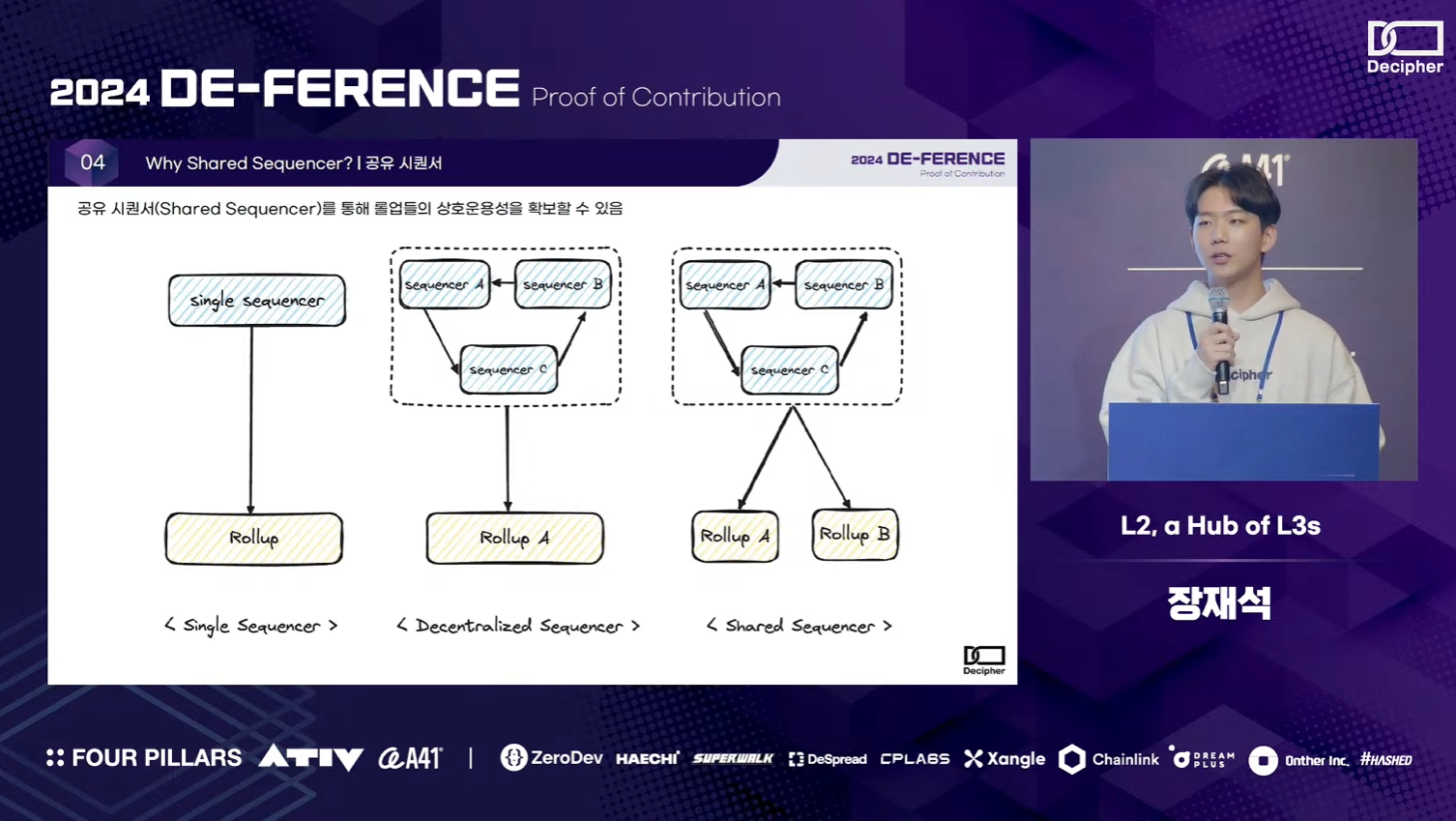
As the L2 ecosystem expands, projects like Optimism, Arbitrum, and Polygon are each building their own ecosystems. Particularly, there are many attempts to build L3 ecosystems on top of L2 using rollup frameworks. The primary motivation for projects to build L3s instead of L2s is interoperability rather than scalability. If L2 serves as a shared sequencing layer for L3 networks, the blocks of L3 networks are generated by the same sequencer set, significantly enhancing interoperability.
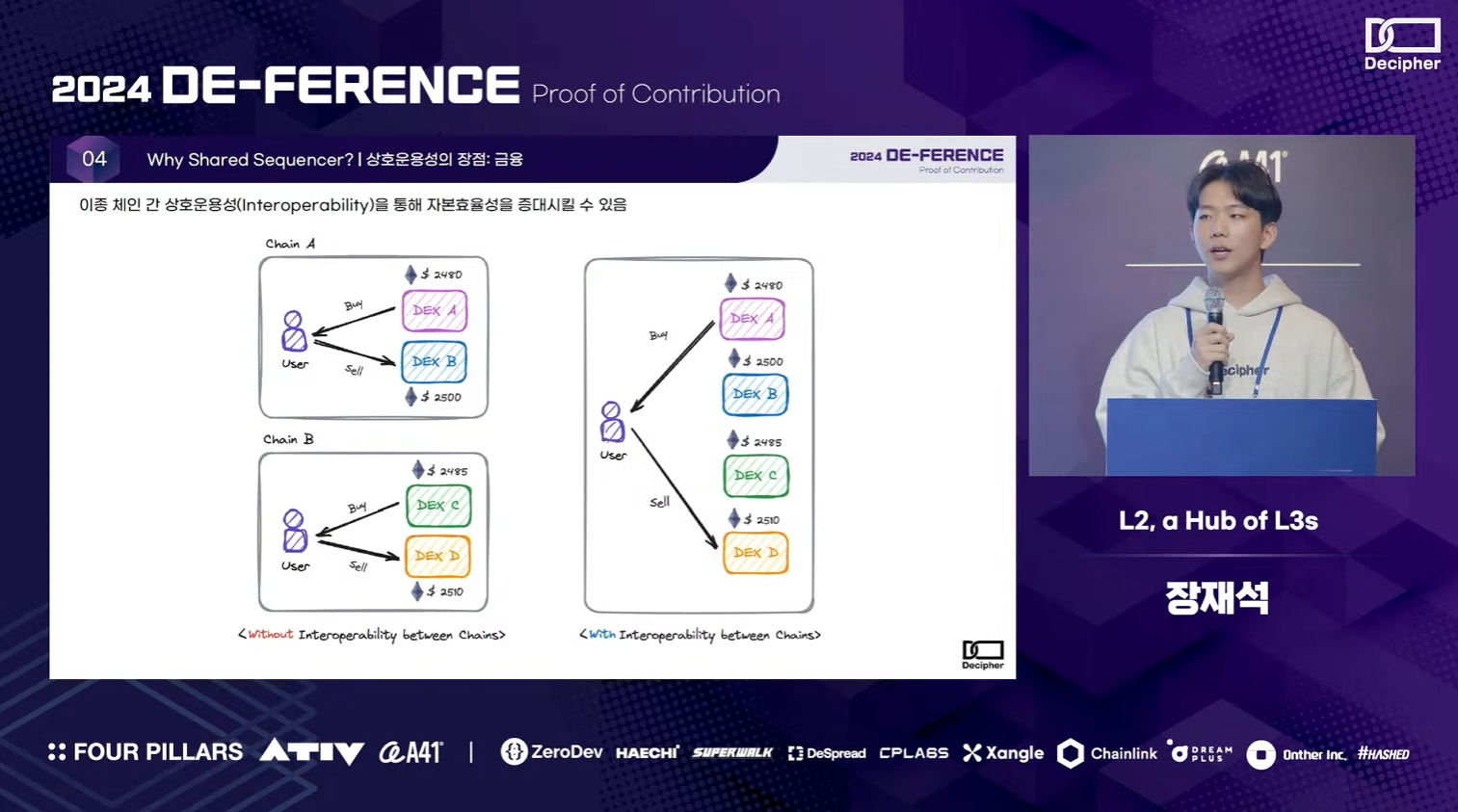
One of the major benefits of significantly improved interoperability is the increased capital efficiency between fragmented assets across various L3 networks. If the market price of a particular asset differs between L3s, arbitrage opportunities between heterogeneous chains were previously unattainable. However, with L3 networks that share an L2, synchronous composability allows for easy arbitrage. This capability is not only advantageous in finance but can also be effectively utilized in games operating multiple servers (L3s).

Leveraging the benefits of L3 mentioned above, the team designed a structure for L2 that can act as a shared sequencing layer. The transaction flow for users is as follows:
Users on the L3 network submit transactions to the Shared Sequencer Mempool on L2.
Sequencers on L2 gather these transactions into SS blocks and include them in the L2 Mempool.
Each L3 network references the SS block, performs computations, and submits the new state to the L2 Mempool.
Sequencers on L2 create L2 Blocks from the L2 Mempool, and L3 networks finalize the state by reading these blocks.
Each L3 generates proofs for the state and submits them to the L2 Mempool.
Finally, the L2 Block is submitted to L1.
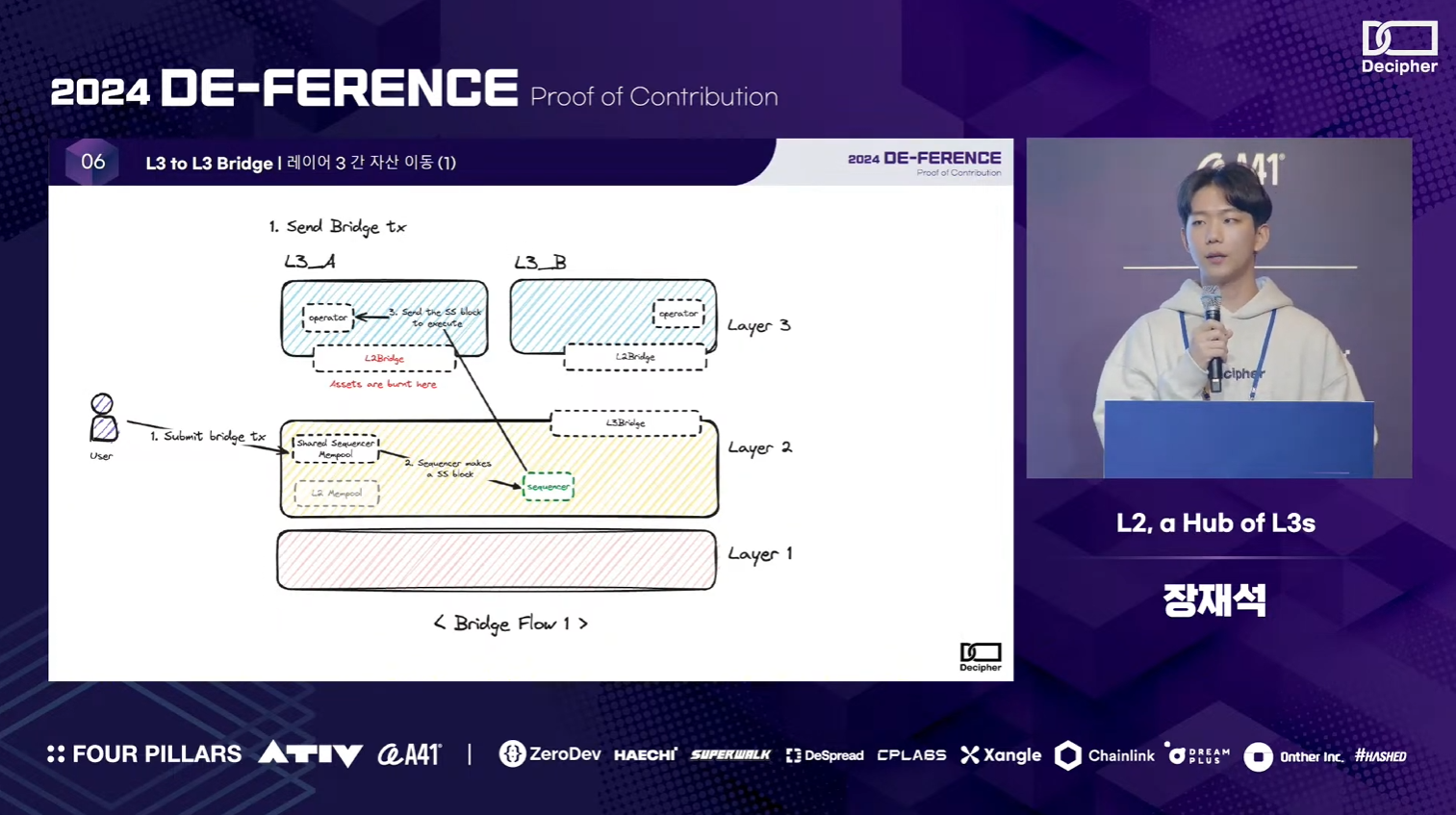
In this structure, all L3s share the same L2Bridge contract, achieving seamless interoperability. The process is as follows:
A user on L3_A submits a bridging transaction to the Shared Sequencer Mempool.
Sequencers on L2 create an SS block and send it to L3.
L3_A's operator verifies the block, burns the bridged asset, and submits a burn message to the L2 Mempool.
Sequencers on L2 execute the transaction and verify the proof submitted by L3_A's operator.
L3_B's operator submits a mint transaction to the Shared Sequencer Mempool based on the message from L2Bridge.
L2 creates an SS block and sends it to each L3.
L3_B executes the SS block, mints the asset, and delivers it to the user.
Similarly, L3-L3 swaps can be seamlessly conducted, addressing the liquidity fragmentation problem among L3 networks.
Overview
The MSM Network team introduced the current issues with zkEVM and presented a new design for proving methods to address these challenges - generating proofs for zkEVM is computationally complex and heavy due to MSM computations. To tackle this, the team introduced a new design called the MSM Network, where decentralized participants, known as crafters, process MSM computations in parallel. They didn't just unveil the architecture; they also demonstrated its effectiveness with benchmarks and a live demo.
Comments
The idea that ZK technology is the endgame for scalability solutions has been around for a long time, but it's true that ZK rollups still lag behind optimistic rollups in many aspects. The core reason for this is the difficulty in generating zero-knowledge proofs (ZKPs) for the computations of virtual machines like the EVM. The team focused on the biggest bottleneck in the proof generation process of zkEVM and introduced a concept for handling this in parallel, which was very intriguing. The benchmarks and demo videos presented by the team further demonstrate the effectiveness of processing MSM computations in parallel.
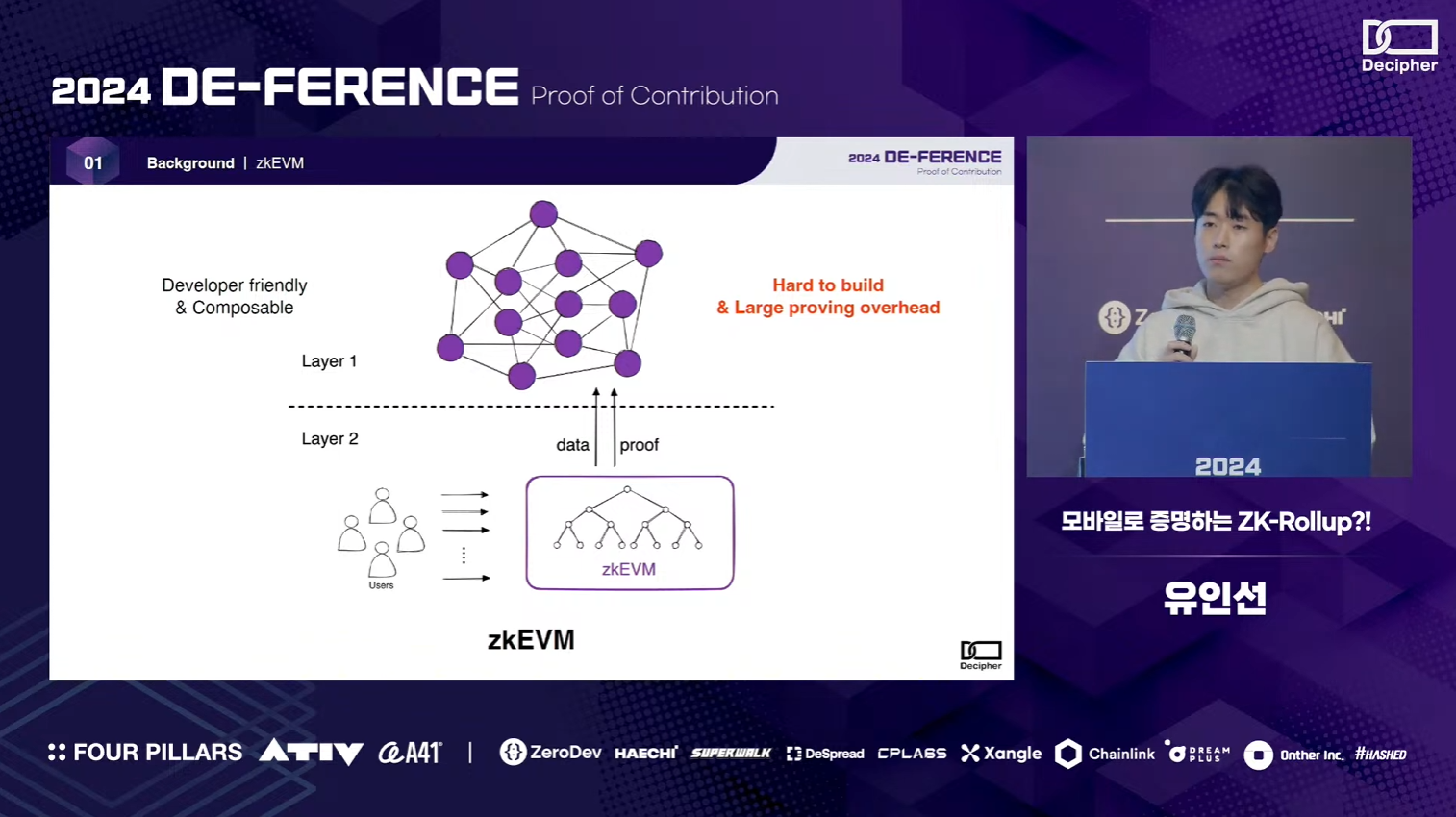
It is well known that decentralized systems like blockchain face limitations in achieving scalability, security, and decentralization simultaneously. In the Ethereum ecosystem, L2 solutions are being actively developed to address these issues, particularly in terms of scalability.
Zero-Knowledge Proofs (ZKP) hold promise for enhancing scalability solutions because they can verify specific computations concisely. However, this is practically very challenging as it requires programming circuits that can generate proofs for computations specific to each application. To address this, zkEVMs, which can generate proofs for all computations at the EVM level, have started to be developed. Nonetheless, building zkEVMs is also very difficult, particularly due to the significant overhead involved in proof generation.
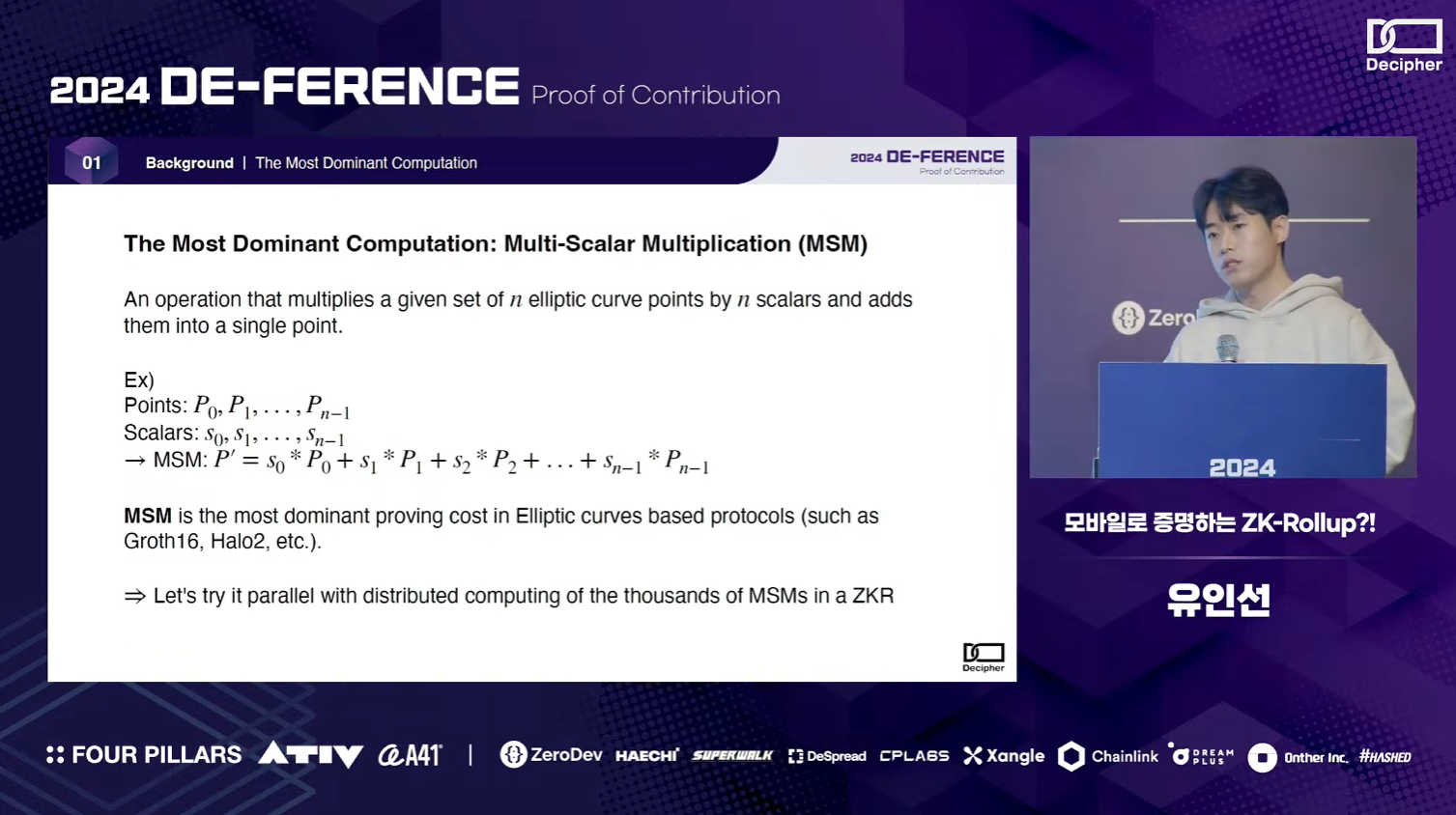
zkEVM primarily uses elliptic curve-based cryptography, where the most dominant operation is Multi-Scalar Multiplication (MSM). MSM involves multiplying several points by several scalars and summing them into a single point. Consequently, the hardware requirements for generating ZKPs are very high. However, if the efficiency of MSM can be improved, the overall efficiency of zkEVM will significantly increase. To address this, the MSM Network team has designed a network that parallelizes MSM.
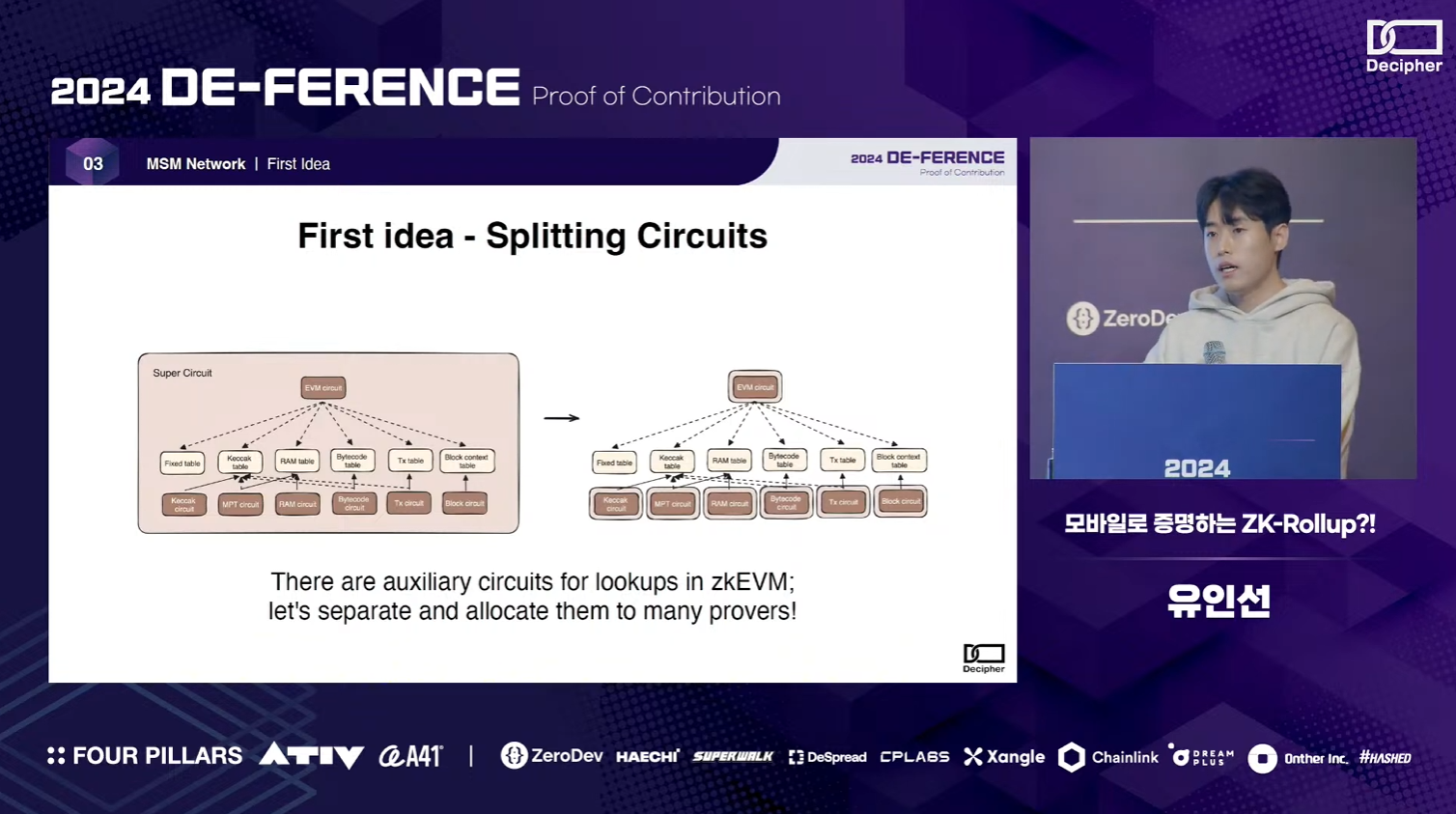
The first idea was to divide the zkEVM circuit. Inside the zkEVM circuit, there are various sub-circuits. Typically, a prover generates a proof for the entire circuit. However, if proofs were generated for individual sub-circuits rather than the whole, the overall proof generation process might be made more efficient. Nonetheless, since the sub-circuits within the zkEVM are often interdependent and contain a lot of redundant logic, this approach does not significantly enhance efficiency in practice.
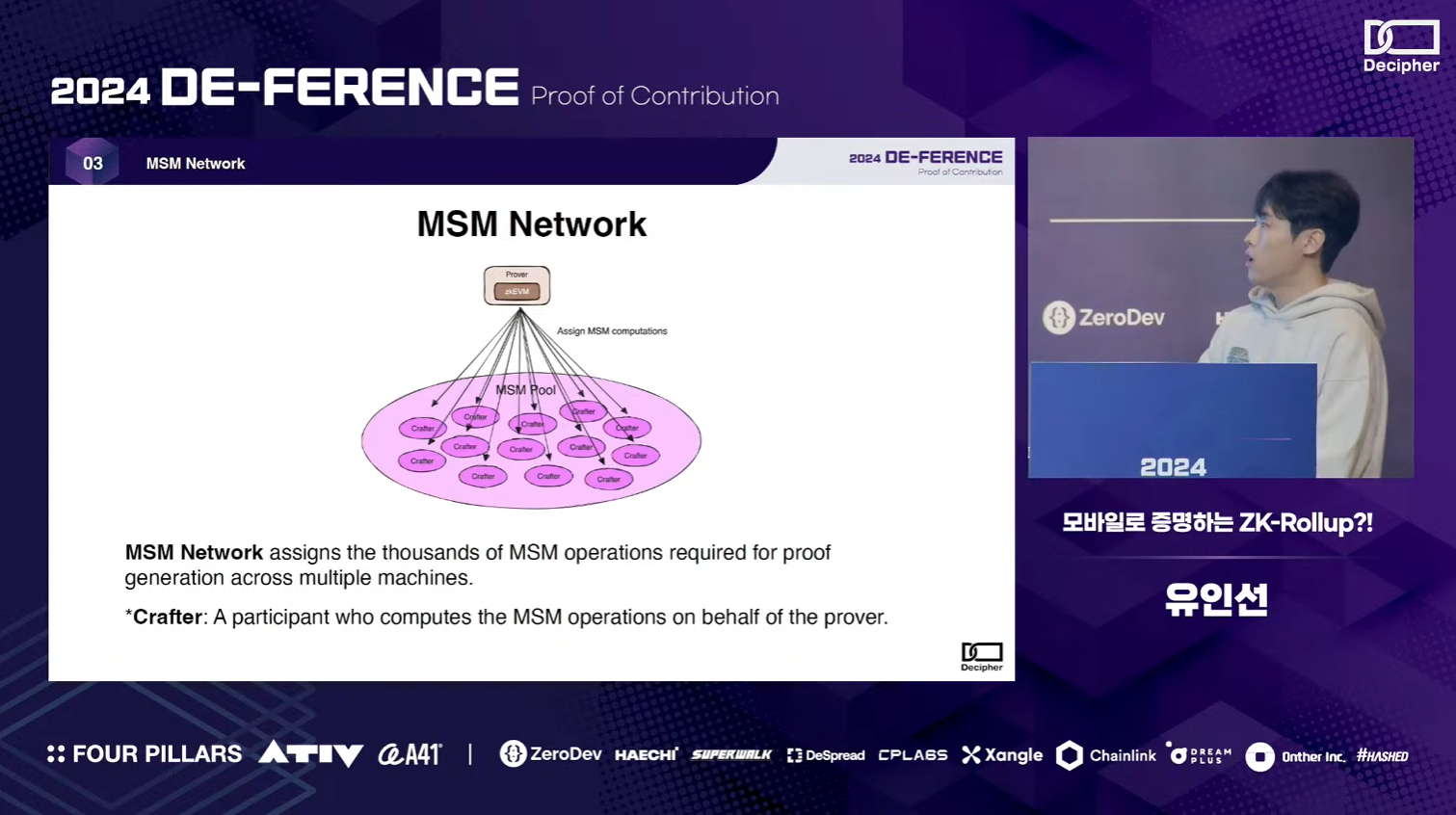
The second idea is to distribute the MSM computation. MSM operations are quite heavy, accounting for 70% of the total cost. To handle this, the prover assigns MSM computations to crafters in the MSM Pool. The crucial point here is that all crafters must perform the MSM computations correctly. To prevent malicious crafters, the team introduced a role called a snooper. If a snooper detects a malicious crafter, they can claim the bond that the crafter has staked.
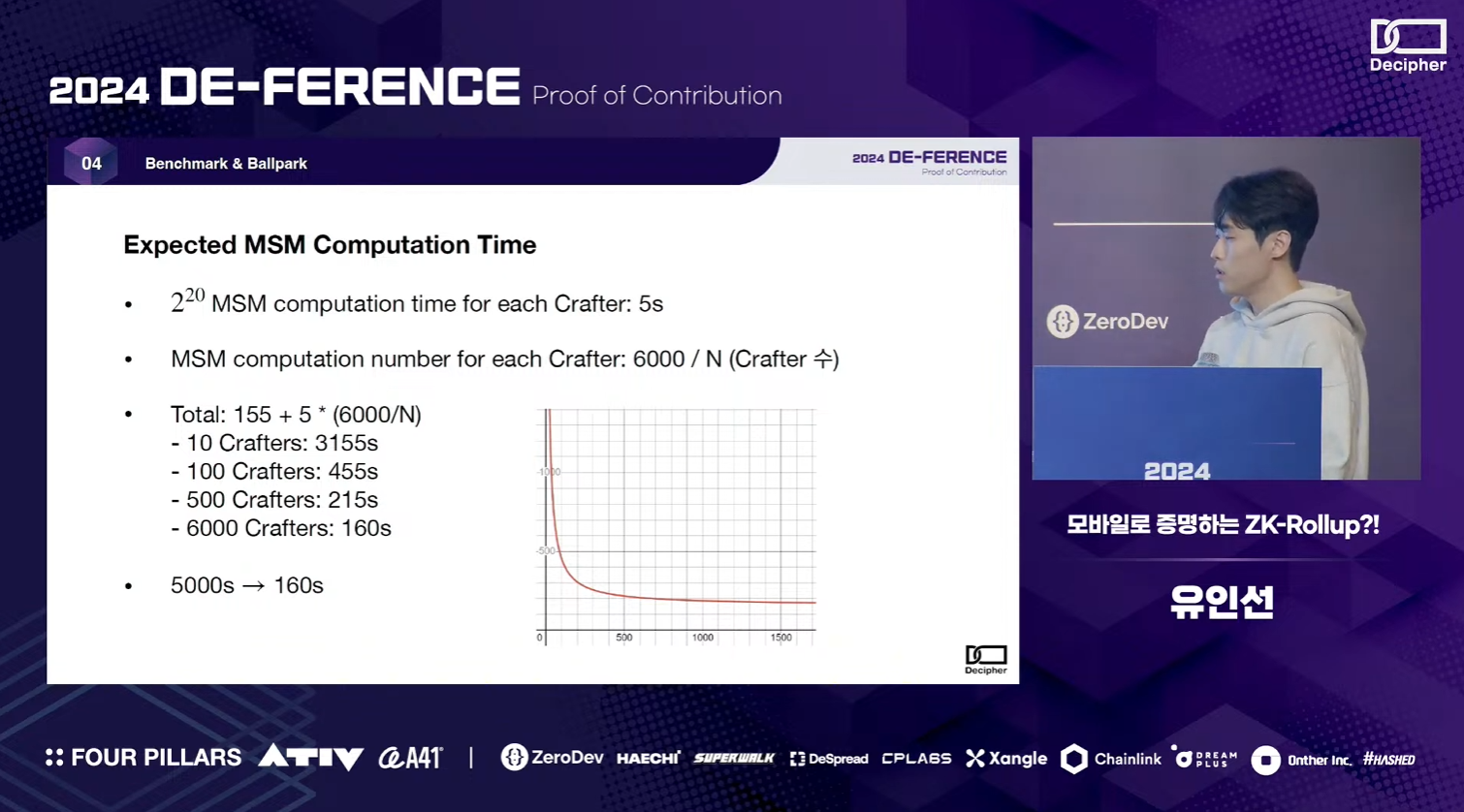
The benchmark results for the MSM network design are as follows. The tests were conducted on a MacBook M2 using the Tachyon library. As the number of crafters increased, the computation time decreased, reducing a single prover computation from 5000 seconds to a maximum of 160 seconds.
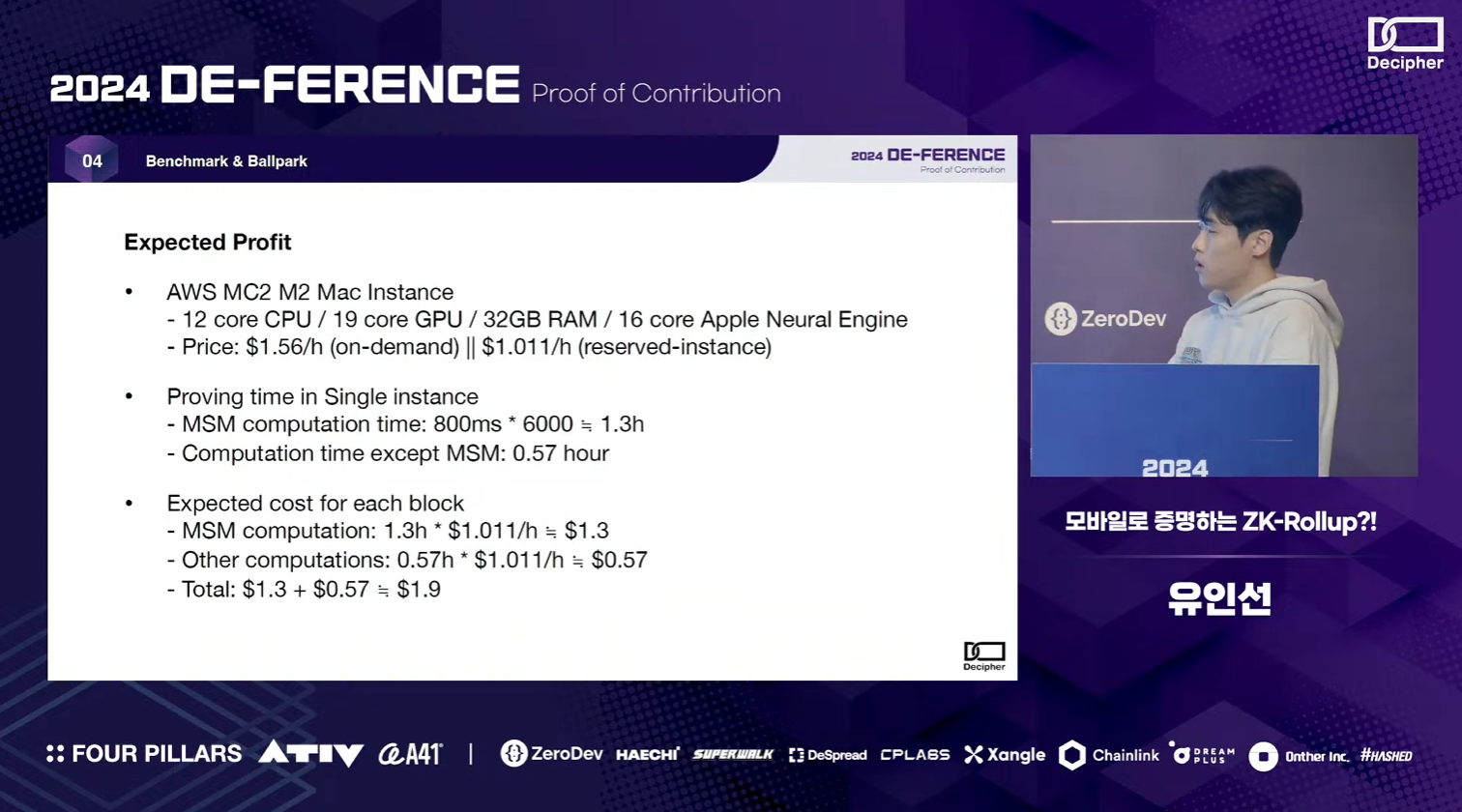
We also calculated the cost savings, finding that each block incurred a cost of $1.9. At the time of the announcement, the average transaction fee revenue per block on the zkSync network was $2.67, indicating that this MSM network design is economically viable. However, more important than the cost is the reduced hardware requirements. Since Crafter handles part of the MSM computations, individuals can participate in verification using personal PCs or smartphones.
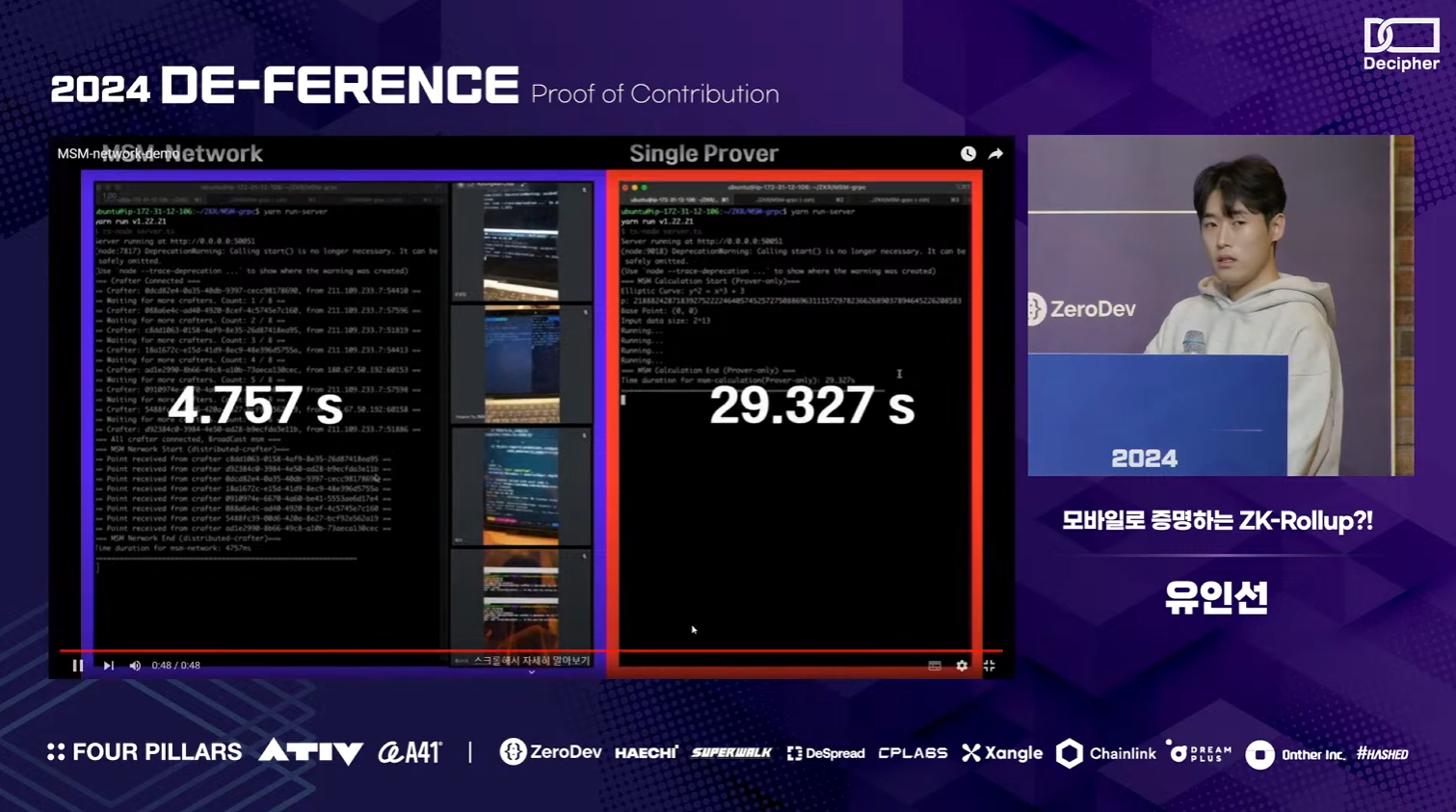
In the demo video, generating proofs for 8 sets of 2^10 computations took 4.7 seconds with 4 crafters, compared to 29 seconds with a single prover.
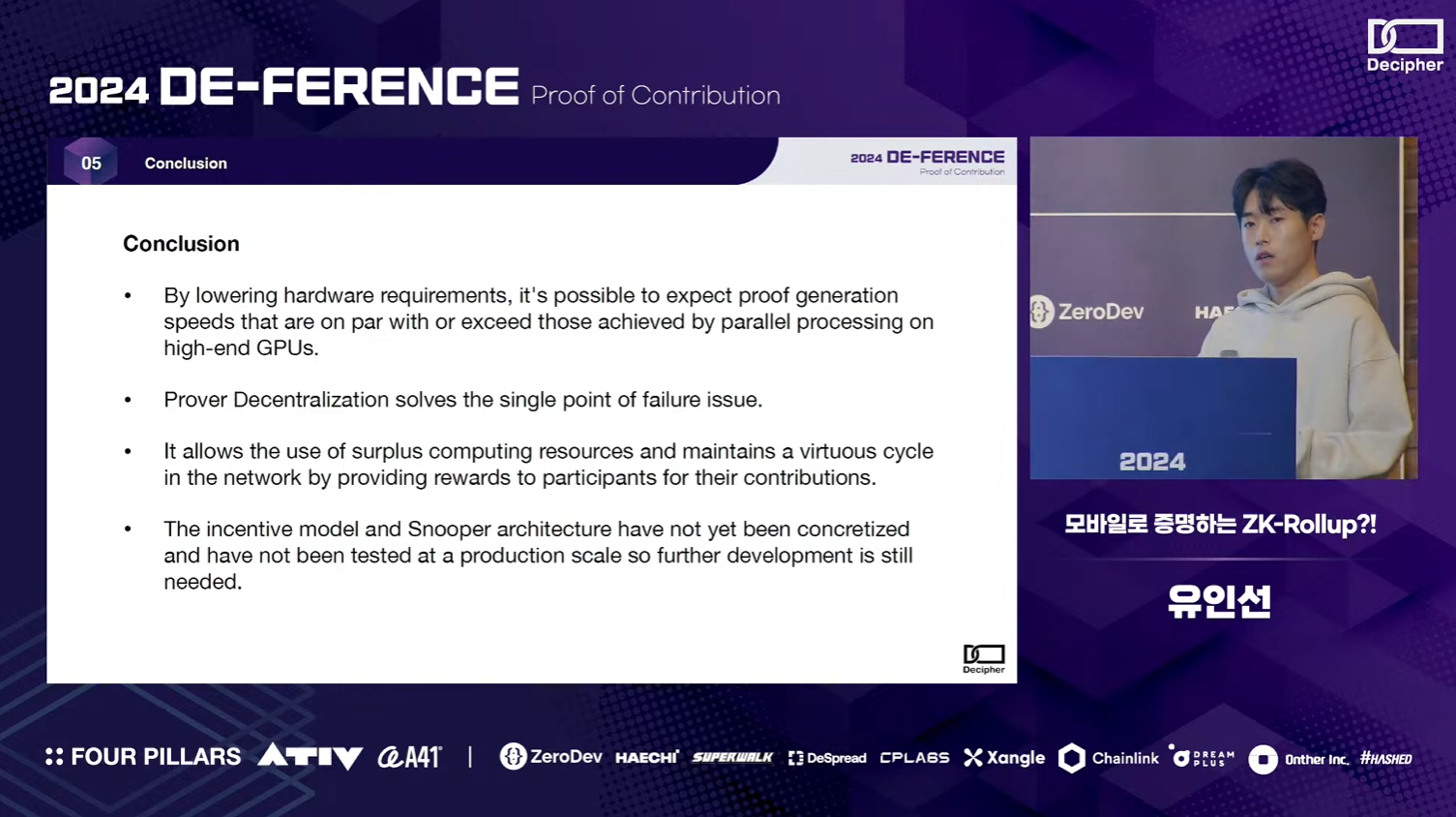
The MSM Network has achieved much higher efficiency and decentralization, even while reducing the hardware requirements for provers involved in verification. Additionally, by using personal PCs and smartphones, it can leverage the idle resources of these devices, further maximizing scalability. However, since the incentive structure for snoopers to prevent malicious activities is not yet clearly designed, further research in this area is needed.
Overview
The final session of part III was a panel discussion titled "Should Blockchains Unite or Separate? (Monolithic vs Modular)." The panel featured Vice President Chanwoo Park of Decipher (A), Team Lead Hyuksoo Jang of A41 (B), Project Manager Joowoong Byun of Four Pillars (C), and Research Lead Jaewon Kim of Xangle (D), with Boseol Moon from Decipher moderating.
Comments
Unlike the past when monolithic blockchains were dominant, recent developments like Ethereum's EIP-4844 and the emergence of Celestia have led to the practical launch of numerous modular blockchains - monolithic and modular blockchains differ in how they handle the core functions of a blockchain (consensus, settlement, data availability, execution). Monolithic blockchains process all these functions within a single network, whereas modular blockchains distribute these functions across multiple networks. Each approach has its distinct advantages and disadvantages, which were thoroughly discussed in this panel discussion.
Discussions
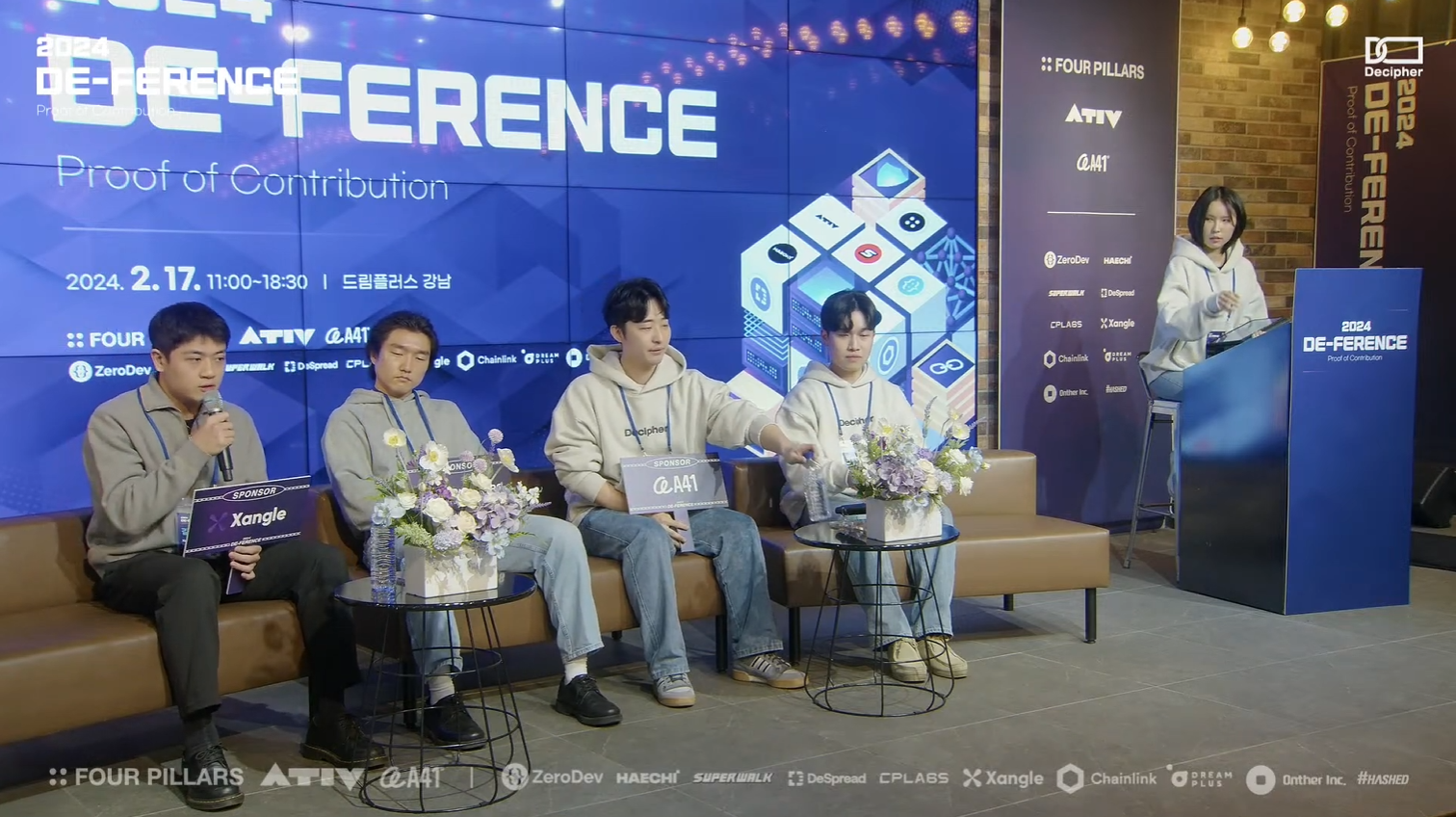
M: Unlike in the past, a variety of monolithic and modular blockchains have emerged recently. What has driven their growth?
B: Recently, many modular blockchains, including L2 solutions, have appeared, similar to the rapid emergence of monolithic blockchains in the past. Modular blockchains, in particular, can delegate security to the base layer and have numerous SDKs available, making them easier to launch to the market compared to monolithic blockchains.
D: From a business perspective, launching a network through a modular blockchain offers significant advantages. First, there is very low competition for block space. Second, it allows for value creation, such as sequencer revenue. Third, managing an independent network allows for custom network design. Lastly, it can easily rely on the robust security of Ethereum.
A: I believe monolithic blockchains offer greater customization than modular ones. Modular blockchains are limited because they depend on the underlying network (Ethereum). In contrast, monolithic networks like Berachain and Monad can grow with their own unique strengths.
C: I think monolithic and modular should be viewed from a strategic perspective rather than just a technical framework. Monolithic blockchains aim for a closed ecosystem model, like Apple, while modular blockchains aim for an open ecosystem. From this standpoint, the modular blockchain ecosystem, with various elements (e.g., security, SDKs) already in place, is growing rapidly.
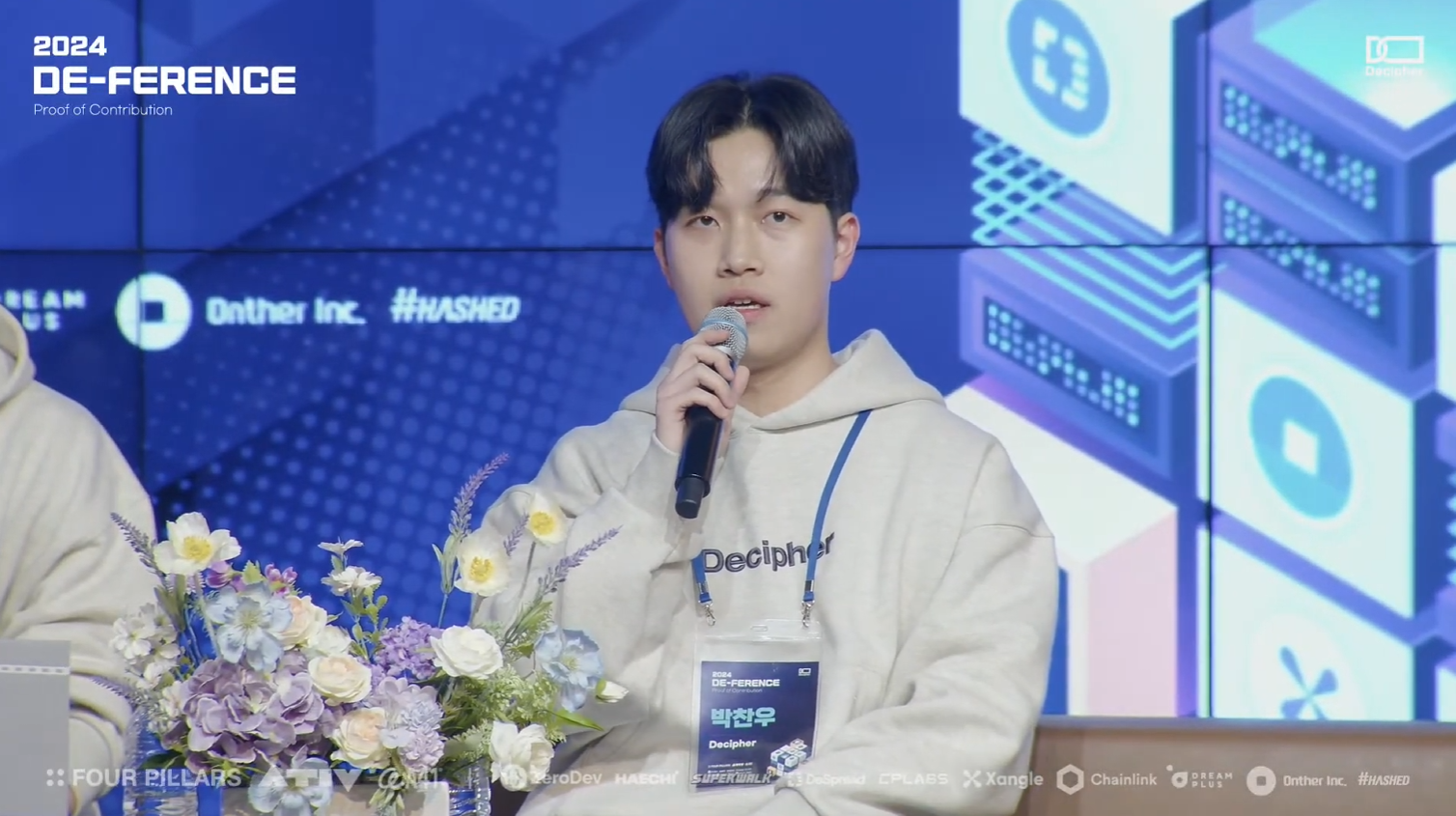
M: What strategies are necessary for monolithic and modular blockchains to gain a competitive edge in the market?
A: Both monolithic and modular blockchains aim to solve scalability issues. Modular blockchains can easily form ecosystems since they can utilize the community and technology of their base layer. However, monolithic blockchains must build their ecosystem from scratch, so securing a strong community is crucial for them.
B: The most important aspect of a blockchain is the level of economic security supporting the network. For modular blockchains like L2s, which rely on the security of L1s, it's important to focus on differentiating themselves from other L2s. On the other hand, L1 blockchains need to prioritize building their own security framework.
C: Monolithic blockchains should leverage their advantages of high speed and low fees by focusing on services like payments that can best utilize these features. Meanwhile, modular blockchain projects seem to be converging on a single focus: interoperability. As mentioned, the ease of launching modular blockchain projects can lead to ecosystem and liquidity fragmentation. To gain a market advantage, ecosystems that address liquidity fragmentation are likely to attract significant attention.
D: Similar to C, monolithic blockchains should find applications that benefit from their speed and low fees. Modular blockchains, on the other hand, need to provide infrastructure that allows projects to deploy blockchains more easily and quickly.
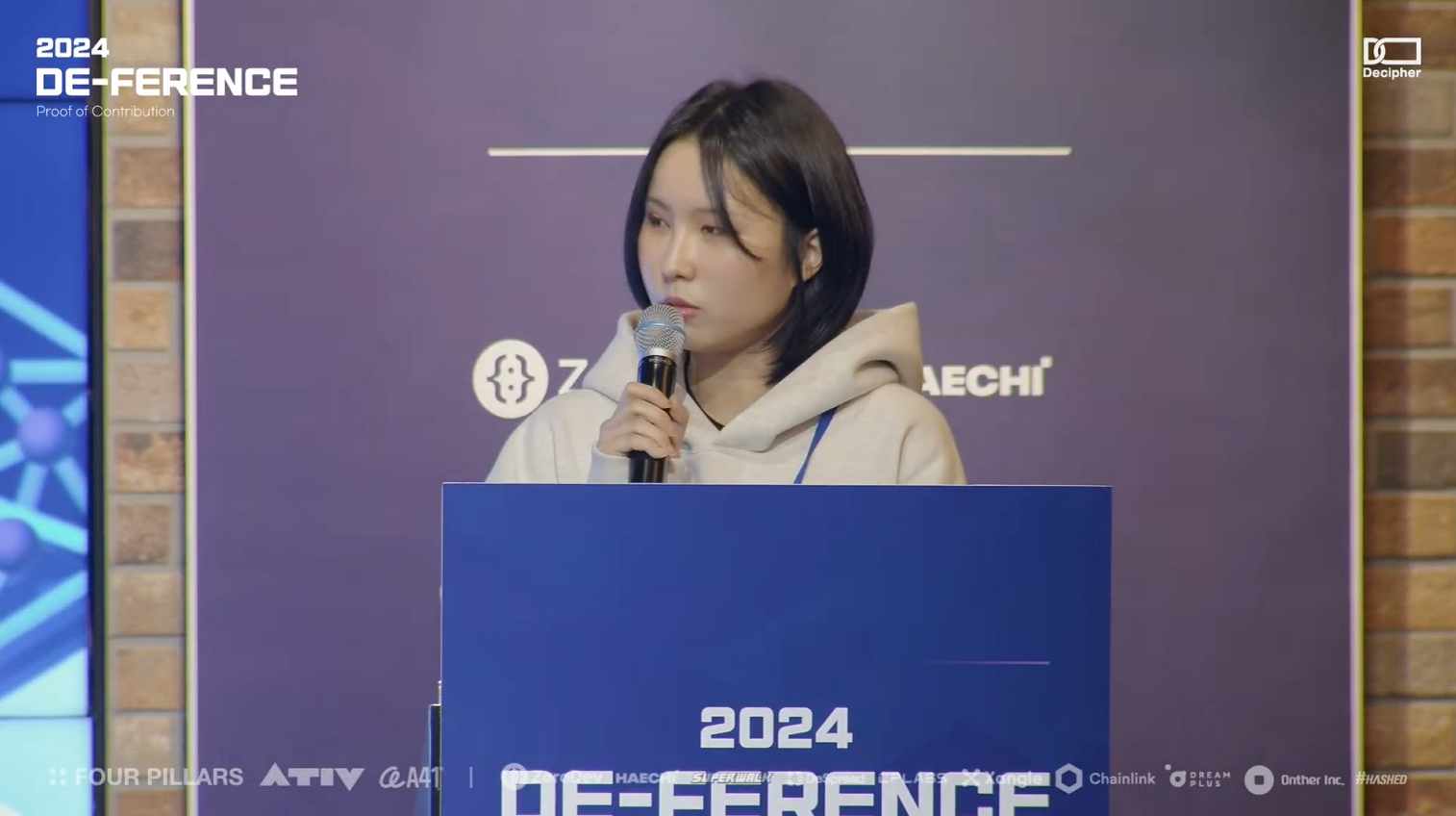
M: As a final question, I'm curious about your opinions on whether modular or monolithic blockchains will dominate in the future, and why.
A: Although many monolithic blockchains have emerged, there aren't many that are fully active yet, and I believe the same will be true for modular blockchains. This is because most of the modular blockchains being launched are general-purpose L2s, and there simply isn't a need for many of these types of networks. Personally, I am excited about intent-based blockchains. Intent-based blockchains have a strong advantage in offering a differentiated user experience, and I believe these types of networks, with their unique strengths, will gain a lot of attention.
C: I think modular blockchains are more likely to dominate. The first reason is the ease of product launches. I recall a comment by Mark Zuckerberg about Apple's Vision Pro—he suggested that as the internet and mobile industries grew, open ecosystems had a higher likelihood of innovation and experimentation compared to closed ones. The second reason is the network effect. Blockchain-based services will soon adopt chain abstraction, and from this perspective, modular blockchains, which can easily tap into large-scale liquidity, will have an advantage.
※ This article series covers the DeFerence 2024 event, sponsored by Four Pillars. This article is the last part of the series. You can check the article for the first part in this link and the second part in this link.
Dive into 'Narratives' that will be important in the next year